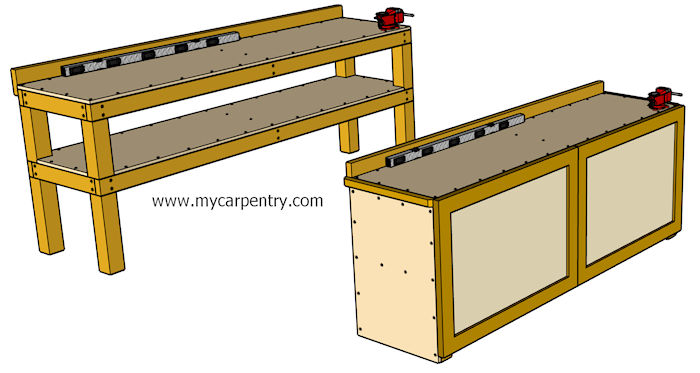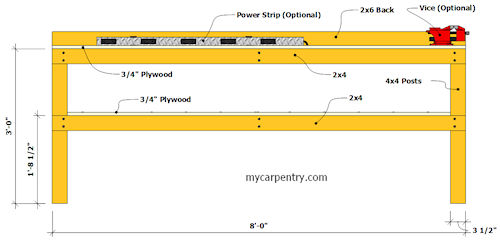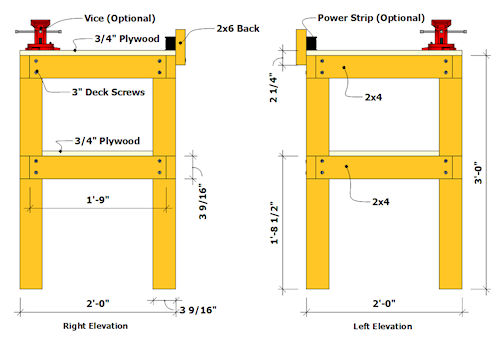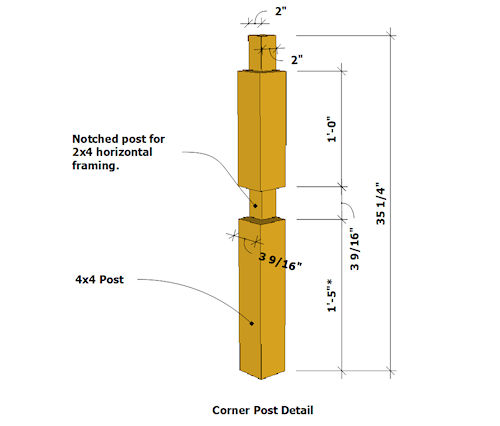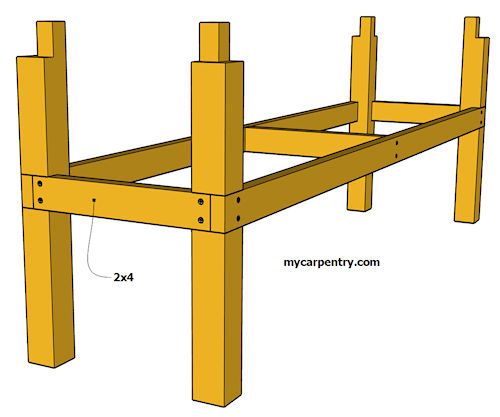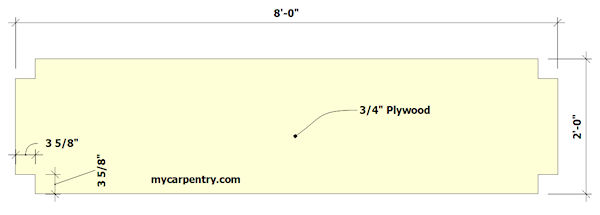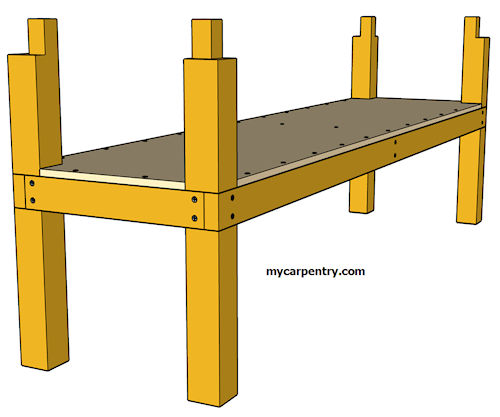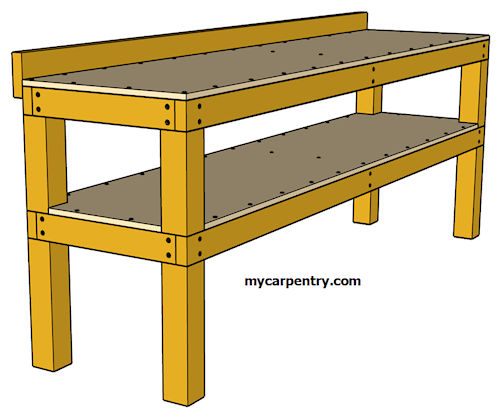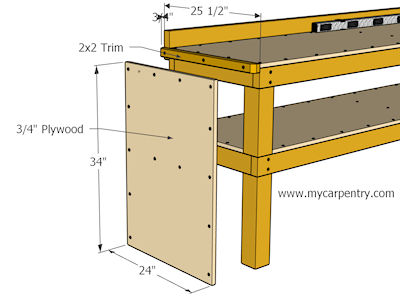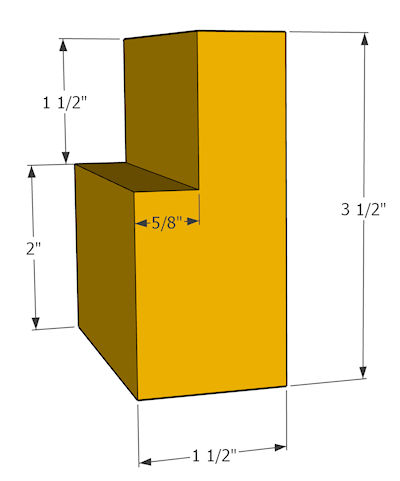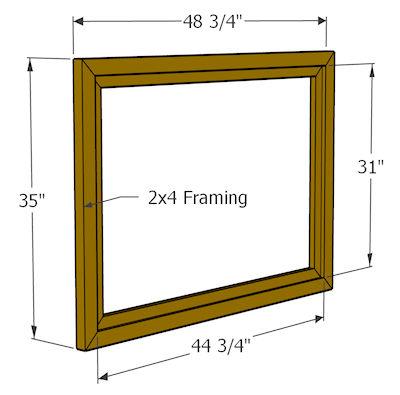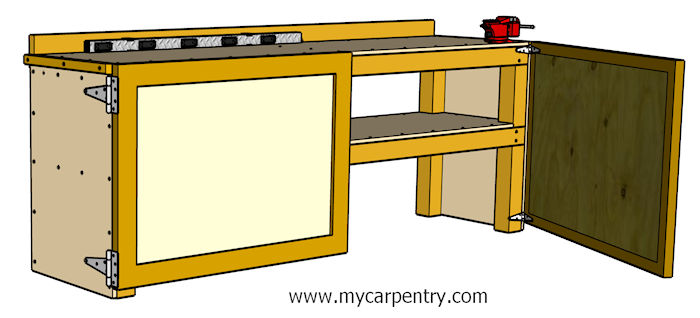Simple Workbench Plans
These simple workbench plans make building a workbench easy. These plans make the most out of nominal sized lumber to minimize leftover material. The top and bottom shelves are cut from a single 4x8 sheet of plywood, and most of the other structural members can be cut from eight 8-foot or 12-foot materials.
Power tools required:- Circular Saw
- Power Drill
- Table Saw (for optional doors)
| Material | Quantity | Purpose |
| 2" x 4" @ 8' | 6 | Horizontal Framing |
| 2" x 6" @ 8' | 1 | Back Board |
| 4" x 4" @ 12' | 1 | Corner Posts |
| 4' x 8' x 3/4" Plywood | 1 | Top and Middle Shelf |
| 3" Deck Screws | 110 +/- | Fasteners (typical) |
Optional Sides and Doors - Material List:
| Material | Quantity | Purpose |
| 2" x 4" @ 8' | 4 | Cabinet Door Frame |
| 4' x 8' x 5/8" Plywood | 1 | Cabinet Doors |
| 4' x 4' x 3/4" Plywood | 1 | End Covers |
| 2" x 2" x 6' | 1 | End Trim |
Simple Workbench Plans - Elevations
Simple Workbench Plans - Building Procedures
- Cut four 35 1/4" corner posts from the 12' 4x4. This leaves very little waste, so be sure to pick out a 4x4 that doesn't have damaged ends.
- Before notching the 4x4 posts, make sure that the notches will accommodate the width and depth of the size 2x4 you are planning to use for the frame. The diagram below, assumes that the 2x4 material is 1 1/2" x 3 9/16".
- Cut two 8' rails from the four 8' 2x4s and attach the two middle ones to the 4x4 posts with 3" deck screws. Make sure that all of the pieces are square before securing them together.
- Cut three 21" 2x4s from the 12' 2x4. Use the three 2x4s to connect the front and back sections of the workbench together (as shown below).
- Rip the 4' x 8' sheet of plywood into two equal halves, taking into account the thickness of the saw blade. Cut the corners out of one of the pieces, as shown below. Note: The corner cutouts assume that your 4x4 posts are 3 9/16" x 3 9/16". 3 5/8" cutouts on the shelf would provide about 1/16" space between the lower shelf and the four corner posts. It is best to measure the partially completed frame for exact dimensions before cutting the plywood shelf.
- Attach the middle shelf to the 2x4 framing using the 3" Deck Screws spaced approximately 8" apart.
- Complete the upper 2x4 framing and attach the remaining piece of 3/4" plywood. Attach the 2x6 Back to the framing using the 3" Deck Screws. (See diagrams above and below)
Notes: Typical garage floors are sloped towards the garage door. If you are planning to place this workbench along one of the side walls of your garage, you might want to shim up the legs on one side so that the surface is level.
Simple Workbench Plans - Optional Doors and Side Panels
- Cut two pieces of 2x2 trim 25 1/2" long. Cut cut a 45-degree angle at each end, leaving 3/4" of the 2x2 at 90 degrees. Attach them to the workbench using three of the 3" Deck Screws. The flat ends should be flush with the front of the workbench and overlap the 2x6 back board, and flush with the workbench surface.
- Cut two pieces of 3/4" plywood 34" x 24". Attach them to each side of the workbench tight against the bottom of the 2x2 trim.
- Using a table saw, notch out the four 8' 2x4s as shown in the detail below.
-
Cut and assemble the pieces of the door frame as indicated in the drawing below. Note that the widths of each door is exactly half of the width of the workbench. In a perfect world, this would always work out, but how the door hangs on the hinges you select might make the doors either too tight, or with an unacceptable gap between them.
I used strap hinges on my doors, because I already had them left over from another project, but there are many hinges to choose from. Make sure that the hinges you select are heavy duty and capable of carrying the weight of the door. - After the door frames are assembled, there should be roughly a 31" x 44 3/4" inset section where the 5/8" plywood fits. Before cutting the plywood centers, measure the actual height and width of the inside. Secure the 5/8" plywood to the 2x4 frame with 1 3/8" wood screws.
Note: I used strap hinges slightly smaller than the ones shown on the left door above. They have worked well for nearly 20 years. If you prefer to use a hinge that is hidden behind the door, you can purchase strap hinges and mount them similar to the door on the right.
What next?
Leave Simple Workbench Plans and visit our home page


